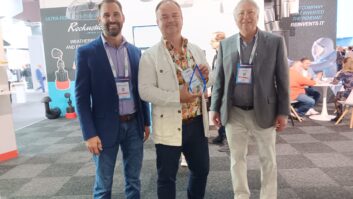
Audio-over-IP for an Entertainment Venue, Part 1
Apr 14, 2010 11:30 AM,
By Bennett Liles
Listen to the Podcasts
|
Editor’s note: For your convenience, this transcription of the podcast includes timestamps. If you are listening to the podcast and reading its accompanying transcription, you can use the timestamps to jump to any part of the audio podcast by simply dragging the slider on the podcast to the time indicated in the transcription.

To provide Nickelodeon Universe with both pushbutton audio control and automated control, DataNab designed a networked audio playback system based on Barix IP technology.
Related Links

Audio-over-IP for an Entertainment Venue, Part 2
DataNab’s Adam VanOort talks about the Barix audio network system installed at Nickelodeon Universe…
DataNab, a firm specializing in audio and video IP network solutions, installed a whole new Barix audio entertainment network for the 7-acre amusement park Nickelodeon Universe in Bloomington, Minn., and Adam VanOort is going to fill us in on all the behind-the-scenes tech details of the installation coming up on the Networked AV podcast.
SVC: Adam, thanks a lot for being with me on the Networked AV podcast. We’re going to talk about Nickelodeon Universe, a big theme park up there in Minnesota. It looks like a fairly massive job here. You’re with DataNab. Tell me a little bit about DataNab and how long that company has been around and what you do.
VanOort: We have been around since about 2003. I was one of the original partners that started the company along with two other guys. We pretty much provide automation and control technologies, products, and solutions that fit into the automation and control spectrum for process controls, monitoring, and really any general type of automation category. And then we also provide IP audio systems and solutions that we resale through Barix. They provide a number of IP audio products that we take and we can resale them just as standalone products, or we create solutions and customize the systems based on those products if necessary. [timestamp: 1:45]
Okay, and it looks like you got called on for a pretty big job with this Nickelodeon Universe. Exactly what is Nickelodeon Universe? I mean, other than being a theme park? Is it sort of inside the Mall of America? I believe it was.
Yeah, the Mall of America. At least at one point, I know [it] was the largest mall in America. I think when it was built it was. I don’t know if anything has been built since then [that is] bigger. In fact, it was the largest indoor mall in the world for some time. I am sure someone has passed that up by now, but Nickelodeon Universe is actually an entire theme park located within the mall, completely inside of it. It’s got roller coasters, flume slides with the water, and a whole bunch of different rides and attractions within that park. So it’s just like any other park that you would go to outside except it’s inside the mall, which is nice in Minnesota especially since it’s pretty cold here for a large part of the year. They needed us to provide them with some ways to get their audio streams or deal with their audio needs, and they wanted it to be as flexible as possible, which led to their requirement of it being network-based; that’s where we kind of came in. [timestamp: 2:58]
Was this a new setup or was it sort of replacing something that they already had?
Nickelodeon was the new sponsor, so it became Nickelodeon Universe and that’s part of this process. They completely tore out the old theme park. I am sure some parts of it were reused, but anything to deal with what we were doing was pretty much designed from the ground up and brand new. They called us because they found Barix—I am assuming online, and we are right in town here too; we are in the Minneapolis/Twin Cities area, but I am sure they found Barix online—and saw that we were the reseller in this area, and they talked to Barix, and Barix recommended that they come to us. Because Barix is the leader in the IP audio field, so that’s how they found them, and then they referred to us through the reseller program that Barix has. [timestamp: 3:46]
Okay, and when they explained to you, [and] when you saw what you had to do, what seemed to be the most challenging aspect of the [install]?
As far as the specifications went, there were some cool requirements in there that dealt with having audio products, the IP audio products, interact with the automation products, in that they needed a large number of pushbuttons to be able to be monitored and then trigger audio feeds to be played from an audio device that has MP3 false start on the USB stick. So typically, you are doing one thing and then the other. You are not mixing and matching these applications, and that was something new. So what we ended up doing is we created a program within the devices that allowed them to communicate with each other. So we have an automation device with a bunch of inputs on it that they can attach buttons to and then we had the IP audio device that could get the status of those buttons from the automation device and then use the change of states and those triggers to trigger an MP3 file to be played off of an attached USB stick. So that was, as far the requirements specification, that was probably the most interesting part of that.
In the installation itself, the most challenging thing was probably the fact that all of the engineering and construction teams at the mall itself were the ones handling the design and installation as far as all the networking, infrastructure, and all the hardware. Our responsibility was to get the solution made for them using the products like I just explained, but then once we got that made, we pretty much handed it off and they had to install it. And as you can imagine, some of these guys, your general electrical contractors and such, don’t have a ton of experience with this type of technology or even low-voltage controls in general. So to get the point across, or to make it very clear to them how this needed to be put together, was probably the most challenging aspect of the installation part—just making [and] getting very specific drawings and instructions to them on how things had to fit together and be wired up and connected. [timestamp: 5:58]
Audio-over-IP for an Entertainment Venue, Part 1
Apr 14, 2010 11:30 AM,
By Bennett Liles

Yeah, it sounds like there could have been numerous potential communication breakdowns there along the way somewhere.
Yeah, there was a couple of times we had to redo some drawings or create new drawings, I should say, to get a little bit more detailed than what we would usually have to do for a job. But once we figured out their level of expertise … then we kind of knew what the expectations were in that. [timestamp: 6:31]
And now they have some applications that use on-demand audio playback. What exactly do they use that for?
They have ride operators basically throughout the park, and you have each ride [that has] different audio files or audio clips that need to be played to the people that are going to be on the ride. So if you’re standing line, they need to be able to tell you instructions for how to get onto the ride and so on and what you are going to do when you get there. When you are on the ride, they need to tell you what you need to do to make sure that you are not going being unsafe while you are on it, and then as you are getting off the ride and exiting, they have another set of instructions. So basically you have a ride operator sitting there or standing next to the ride with a panel of pushbuttons in front of him, and [with] the pushbutton, they can use to trigger all of these different MP3 clips or audio clips to be played to the correct people in their locations. So as you progress through the ride, you are going to hear different things, and those are all triggered by the operator. It’s not automated or anything because there’s too many different things going on to automate all of that, so the ride operator themselves trigger the audio files to be played at the correct times to the correct people from this operator panel and those buttons then—as I kind of mentioned before—are wired into to one of our I/O devices. In this case, it’s a Barix IO12, which has 12 inputs on it. So those inputs sample regularly to see if the buttons are changing states, and once they have changed states, the Annuncicom learner hears it from the IO12 that they have changed states and then the Annuncicom can use that information to decide when and what audio file to play. [timestamp: 8:06]
Basically stuff like, “Keep your hands and arms and stuff within inside the cart at all times,” stuff like that?
Exactly, that’s the basic stuff, and then when you get in and get on the ride, “Make sure you fasten your seat belts,” or, “Stand behind the yellow line.” I haven’t personally been through the rides more than maybe once with my kids since the whole thing was installed, but yeah, it’s the standard theme-park stuff that they are triggering to be played. [timestamp: 8:32]
Where is the central control for all this? There must be some central place where it all comes together.
Well, as far the part that we just talked about, with the local announcement at each ride or attraction, those are basically just controlled there locally by the operators. There are a few other pieces that go to this system that are a bit more automated or less critical locally. And one example of that would be, for instance, the general background music that you will hear as you are walking through the park, whether it’s a SpongeBob ad or music like that that the kids can hear and be entertained with just walking around the park or different advertisements or announcements. Those things are all streamed from the central location over the network. In that case, we use the Instreamer 100 from Barix as the IP audio encoder. So it takes just your standard feed from—it’s not CD players anymore, it’s probably some MP3-based server system or on-demand audio system but a standard RC output for instance, can go on this Instreamer 100—it takes that feed and codes it and sends it over the network to multiple Exstreamers located all over the park. In that case, everything is controlled from the location where that central playback device is, whether it’s a server with MP3 files on it or a mixing board or something like that, and the Instreamer is located right there and then it sends it to all the Exstreamers over the network around the park. [timestamp: 9:59]
It goes over just a regular IP network park-wide?
Yeah, which is what the power to the whole system is, which is why … they decided to go with the Barix system, because they had planned to already run network all over the park, and this prevents them from needing to have a dedicated audio network polled as well in addition to your communications network. The second application for those same exteriors is for the emergency broadcasts/emergency notifications, so at any given time, if there needs to be an emergency notification made, personnel can tie into that same system and send audio feed at a higher priority out to the same Exstreamer, then that will override the background music or whatever was being played so they can hear the security personnel or whoever it is or even a recorded announcement or recorded notification being sent. They can hear that all throughout the park then as well on the same Exstreamer 100s. [timestamp: 10:53]
You were talking about the Annuncicoms earlier. They’ve got audio clips stored on those. How do you store the audio clips on the Annuncicom s?
The Annuncicoms have a USB interface on them, so you can just take a standard USB memory stick and load it with a list of MP3 files onto those, and then the Annuncicoms can pull those files off and play them either on-demand or they can just loop through them or however you program it to be used. It’s also actually possible to record MP3 files onto those USB sticks using the Annuncicom so you can have a microphone in an area and then have that attached to the Annuncicom 100, and then when you trigger it to record, it can record the files right onto that USB stick in MP3 format and then even upload it to an FTP site or something along those lines. So it’s a really flexible controller device. It’s got audio interfaces, I/O interfaces, serial interfaces, and this USB interface, and put it all together and you’ve got yourself a pretty capable device. The main reason why the mall, I think, went with that device is their standard unit. [timestamp: 11:58]
Especially since it’s such a geographically spread out area, you’re not talking about something that’s all within an arms reach here. Now, the Instreamers and Exstreamers, what sort of audio formats can they handle? What kind of connectors do you actually do the interface on them?
The Instreamer is the encoder, so that is why it’s called the Instreamer. It puts the audio into the network. Whereas the Exstreamer takes it off the network. But the Instreamer itself, the Instreamer 100, has a left and a right channel, so stereo input for RCA, your standard RCA, and it also has a S/PDIF input for digital interface, and regardless of which one it takes, then it can encode those streams into different formats of audio. The basic standard one that most people are interested in is MP3 of course because of the good compression capabilities, and it reduces the amount of bandwidth that you would need. G.711 is also an option. It’s another commonly used one in voice-over-IP applications. Things like Skype, I believe, would use G.711 encoding. [timestamp: 13:04]
All right, which I happen to be using right now.
Oh, okay, oh yeah. So the Instreamer can handle that in A-Law or u-Law formats, up to 24K. And then PCM is also supported by the Instreamer, and actually, that’s now supported by up to 48K uncompressed—which is quite a bandwidth hog—but if you really need a large amount of quality, the very highest quality, then that’s an option as well. [timestamp: 13:31]
These things are very small. I saw the pictures, and it looks like you could just stick some Velcro on one of these and stick it on the underside of a table or something.
You could. They are only a few inches wide, probably 4in. wide, 3in. deep, and 1.5in. tall. They do come with some mounting options. We sell the little mounting brackets they can be used with, so you don’t have to put Velcro on there, but if you wanted to, you definitely could, and they can also be mounted in 19in. racks. We’ve got a little adapter rack plate that you can use to do that. I was going to save it for the Exstreamer 100s, the matching device for the Instreamer. It’s the one that takes audio off the network, and it can actually decode audio streams from the Instreamers as well as pretty much any other generic network audio source, whether it’s Internet radio, ShoutCast, Windows Media and decoder, or any of those. So the Exstreamer is made, first and foremost, to be a network audio decoder, a general network audio decoder, but, secondly, it’s also the perfect match for the Instreamer if you are also using that device. [timestamp: 14:36]
Fantastic, Adam. This has been great having you on here for part one and talking about the Nickelodeon Universe and the Barix audio network there. In part two, we are going to be getting into more of how you set it up and kind of get that thing up and running.
All right. Thank you. [timestamp: 6:31]










